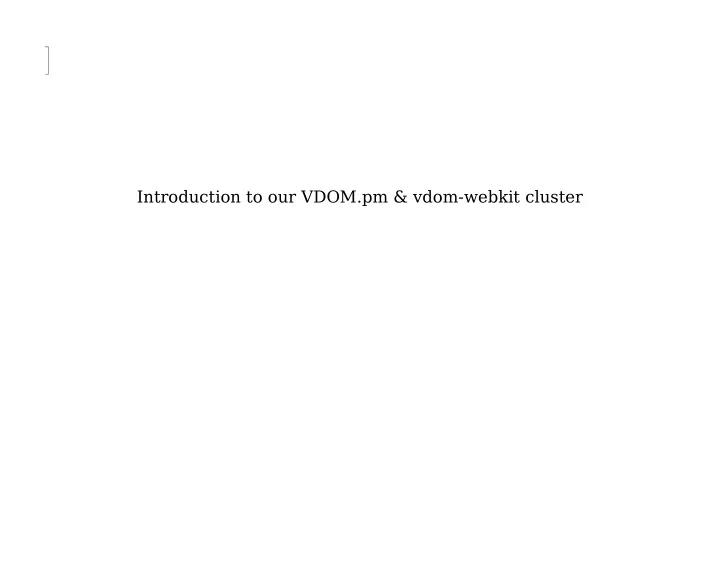

Introduction to our VDOM.pm & vdom-webkit cluster
Introduction to our VDOM.pm & vdom-webkit cluster ☺ agentzh@yahoo.cn ☺ 章亦春 (agentzh) 2009.9
VDOM ➥ Visual DOM ➥ DOMs with vision information
window location="http://foo.bar.com/index.html" innerHeight=802 innerWidth=929 outerHeight=943 outerWidth=1272 { document width=914 height=5119 { ... } }
BODY x=0 y=0 w=914 h=5119 fontFamily="Helvetica,Arial,sans-serif" fontSize="12px" fontStyle="normal" fontWeight="400" color="rgb(0, 0, 0)" backgroundColor="rgb(255, 255, 255)" { "\n " w=0 { } DIV id="append_parent" x=0 y=0 h=0 backgroundColor="transparent" { " 首页 \n\n" x=1 y=1 { ... } } "\n " w=0 { } }
FONT color="rgb(255, 0, 0)" { B fontWeight="401" { " 购物 " h=32 w=56 { } } }
"Why another language?" "Why not just borrow HTML or XML's syntax?"
✓ We want to keep VDOM dump size small . ✓ We want to keep VDOM dump unambiguous . ✓ We want to make VDOM more human-readable and more human-writable. (Yeah, XML/HTML's syntax is very cumbersome .) ✓ We want to make VDOM parsers & dumper trivial to implement and verify. (tens of lines of Perl for example ;)) ✓ Low level structures like text runs and text nodes are hard to express naturally in HTML or XML.
☺ We've already made both Mozilla Gecko and Apple WebKit emit VDOMs
# Generate VDOM from the command line: $ vdomkit --enable-js --proxy=proxy.cn:1080 \ http://www.sina.com.cn > sina.vdom # Or access our vdomkit FastCGI server directly by HTTP: $ curl 'http://vdom.cn.yahoo.com/vdom?url=http%3A%2F%2Fwww.sina.com.cn' \ > sina.vdom
# The VDOM dump is much smaller than the original HTML: $ ls -lh sina.vdom -rw------- 1 agentz agentz 278K 2009-04-10 10:30 sina.vdom $ ls -lh sina.html -rw-r--r-- 1 agentz agentz 400K 2009-04-10 10:34 sina.html
✓ Now Perl enjoys very powerful DOMs as good as those in JavaScript.
use VDOM; open my $in, "sina.vdom" or die $!; my $win = VDOM::Window->new->parse_file($in); my $body = $win->document->body; for my $child ($body->childNodes) { print $child->tagName; print $child->x; print $child->h; print $child->color; print $child->fontFamily; ... }
print $child->nextSibling; $win->document->getElementById("foo"); # These are Firefox 3.1 DOM methods, we have too ;) print $child->previousElementSibling; print $child->firstElementChild; print $child->parentNode; print join ' ', map { $$_->href . ': ' . $$_->textContent } $child->getElmenetsByTagName("A");
☺ Debug our Perl code from within Firefox via our Visual DOM extension
☺ The qt-webkit port of our Visual DOM extension: VDOM Browser
☺ We can get geometry information of every text nodes in the DOM!
...or even as small as text runs ! (text run is the undividable component of a text node which has no line breaks in it)
☺ Put everything into a cluster .
☺ Most of the components have been opensourced
QtWebKit with VDOM support ➥ http://github.com/agentzh/vdomwebkit/
vdomkit ( command-line utility and web interface) ➥ http://github.com/agentzh/vdomkit/
VDOM Browser ➥ http://github.com/agentzh/vdombrowser/
VDOM.pm ➥ http://github.com/agentzh/vdompm/
queue-size-aware version of memcacheq ➥ http://github.com/agentzh/memcacheq/
Queue::Memcached::Buffered (a Perl client for memcacheq) ➥ http://github.com/agentzh/queue-memcached-buffered/
Acknowledgements ☺ haibo++ persuaded me to believe that the separation of browser rendering engines and our hunter extractors via VDOM dumping could give rise to lots of benefits. ☺ jianingy++ effectively fired the great WebKit craze in our team. ☺ xunxin++ ported Visual DOM extension's JavaScript VDOM dumper to qt-webkit C++ and did most of the hard work in vdom-webkit . ☺ xunxin++ ported patched sina's memcacheq to make it aware of queue sizes. ☺ mingyou++ shared a great deal of his knowledge of the WebKit internals with us and also gave very good suggestions for the slides you're browsing.
☺ Any questions ? ☺
Recommend
More recommend